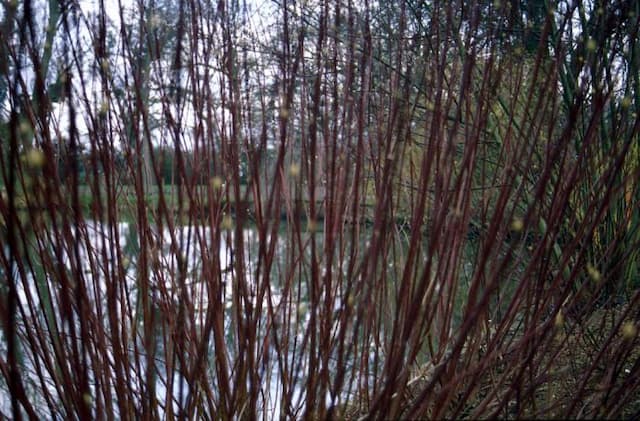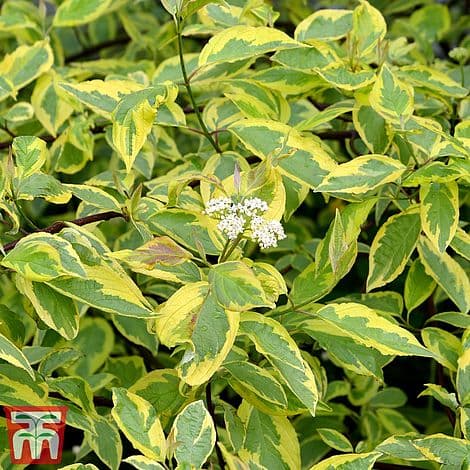Dogwood Cornus sanguinea











ABOUT
The plant commonly known as Dogwood is a decidaceous shrub that is well known for its ornamental qualities. This particular type boasts a multitude of stems that emerge from its base, giving it a full and bushy appearance. In the springtime, it produces an abundance of small, creamy white flowers that cluster together in attractive displays. Each individual flower is quite modest in size and is composed of four small petals that surround a center of more pronounced yellowish stamens. As the flowering season progresses, these blooms give way to round, blackish-blue fruits. The fruits are a stark contrast to the surrounding foliage and are attractive to various bird species who enjoy them as a food source. The leaves of the Dogwood are distinctly shaped, being oval with pointed tips and curving veins that create a net-like pattern. They have a smooth texture and a color that is a vibrant green throughout the spring and summer. In the autumn, one of the most striking features of the Dogwood is the transformation of its leaves. They undergo a dramatic change, taking on fiery shades of red and purple, which create a stunning display against the backdrop of the fading landscape. Another notable characteristic is the color of its bark and branches. The younger branches exhibit a reddish or purplish hue which stands out, particularly in winter when the plant has shed its foliage, highlighting the colorful stems against the starkness of its surroundings. This winter interest makes the Dogwood a popular choice for adding color to gardens during the colder months.
About this plant
 Names
NamesSynonyms
Common Dogwood, Bloodtwig Dogwood, European Dogwood, Dogberry, Hound's Tree.
Common names
Swida sanguinea, Thelycrania sanguinea, Cornus mascula.
 Toxicity
ToxicityTo humans
The plant commonly known as Bloodtwig dogwood is not known to be highly toxic to humans. However, the consumption of any part of the plant, particularly the fruit, can potentially cause minor symptoms such as stomach discomfort or nausea. It's always important to exercise caution and avoid eating plants not known to be edible or those you're not familiar with to prevent any adverse reactions.
To pets
Bloodtwig dogwood is not commonly known as a toxic plant to pets. While it is not considered highly poisonous, ingestion of the plant parts, especially the berries, could cause mild gastrointestinal upset in animals such as dogs and cats. Symptoms might include vomiting or diarrhea. As with any non-food plant material, pets should be dissuaded from eating Bloodtwig dogwood to prevent any potential discomfort or symptoms that could arise from ingestion.
 Characteristics
CharacteristicsLife cycle
Perennials
Foliage type
Deciduous
Color of leaves
Green
Flower color
White
Height
10 feet (3 meters)
Spread
8 feet (2.4 meters)
Plant type
Shrub
Hardiness zones
4
Native area
Europe
Benefits
 General Benefits
General Benefits- Wildlife Habitat: Cornus sanguinea, commonly known as dogwood, provides shelter and nesting sites for birds and other wildlife.
- Ornamental Value: With its striking red stems in the winter and white flowers in spring, dogwood adds aesthetic value to gardens and landscapes.
- Erosion Control: The root system of dogwood helps stabilize soil and prevent erosion on slopes or banks.
- Seasonal Interest: Dogwood offers year-round interest with spring blossoms, summer berries, autumn foliage, and vibrant winter stems.
- Food Source for Wildlife: The berries produced by dogwood are a source of food for birds and small mammals during autumn and winter months.
- Pollinator Support: The flowers of dogwood provide nectar and pollen for bees and other pollinators during the blooming season.
- Habitat Diversity: Planting dogwood contributes to the diversity of plant species in an area, supporting a healthier ecosystem.
 Medical Properties
Medical Properties- Anti-inflammatory: Cornus sanguinea has been traditionally used for its potential anti-inflammatory effects.
- Antipyretic: The plant has been used to reduce fever in folk medicine.
- Antioxidant: Compounds in Cornus sanguinea may exhibit antioxidant properties.
- Diuretic: There is a traditional use of the plant as a diuretic, promoting the excretion of urine.
- Antimicrobial: Some studies suggest that extracts from the plant may have antimicrobial activity against certain pathogens.
 Air-purifying Qualities
Air-purifying QualitiesThis plant is not specifically known for air purifying qualities.
 Other Uses
Other Uses- Cornus sanguinea, commonly known as dogwood, has been historically used for creating inks, due to its bark containing tannin that can produce a range of colors from yellow to deep black.
- The wood of dogwood is extremely hard and has been traditionally used for tool handles, including hammers and other impact tools, due to its ability to absorb shocks without splintering.
- Dogwood branches are flexible and can be used in basket weaving, offering durability and a unique appearance to handmade baskets and crafts.
- In rural communities, dogwood twigs have been used as toothbrushes, where the fibrous ends act like bristles to clean teeth and stimulate gums.
- The dense wood of dogwood is suited for woodturning and has been crafted into small decorative items such as goblets, bowls, and figurines.
- Due to its dense grain, dogwood wood is an excellent choice for making musical instruments such as woodwind bodies and piano keys.
- Artisans have used dogwood wood for detailed carving works including ornamental designs and intricate sculptures, taking advantage of its fine-grained texture.
- Dogwood can be utilized in charcoal production, providing a high-quality charcoal for artists' drawing materials.
- Some cultures have used the bright red branches of dogwood in landscape design, especially in the winter months when the color provides visual interest against snow-covered backgrounds.
- Young dogwood shoots have been fashioned into walking sticks and canes, prized for their straightness and strength.
Interesting Facts
 Feng Shui
Feng ShuiThe plant Cornus sanguinea, commonly known as Dogwood, is not used in Feng Shui practice.
 Zodiac Sign Compitability
Zodiac Sign CompitabilityThe Dogwood is not used in astrology practice.
 Plant Symbolism
Plant Symbolism- Vitality: The Cornus sanguinea, commonly known as the Bloodtwig Dogwood, often has vibrant red stems that signify life and energy, representing the vigorous life force and vitality present in nature.
- Protection: In folklore, dogwood trees are sometimes associated with protection and safety, believed to guard against negative energies and provide a sacred space.
- Stability and Resilience: Bloodtwig Dogwoods have a strong root system and a sturdy structure, symbolizing a person's ability to stand firm and resilient in the face of difficulties.
 Water
WaterCommon Dogwood, or Cornus sanguinea, prefers consistently moist soil, and watering should be sufficient to keep the soil from drying out completely. During the growing season, which is from spring through summer, water the plant deeply once or twice a week, depending on weather conditions. Aim for about 1 to 1.5 inches of water per week, which translates to approximately 0.6 to 0.9 gallons for a medium-sized shrub. In the fall and winter, reduce watering as the plant's growth slows down. Ensuring proper drainage is crucial to prevent waterlogging and root rot.
 Light
LightCommon Dogwood thrives in a spot with full sun to partial shade. Ideally, it should receive at least four hours of direct sunlight each day but can tolerate some shade, especially during the hotter part of the day. A location that offers morning sunlight and afternoon shade is optimal for this plant's health and flowering potential.
 Temperature
TemperatureThe ideal temperature range for Common Dogwood is between 60°F and 75°F. It can withstand minimum winter temperatures down to about -30°F and summer highs up to around 95°F. This plant is tolerant of a wide range of temperatures and is hardy in USDA zones 3 through 8, making it adaptable to many climates.
 Pruning
PruningPruning the Common Dogwood promotes healthy growth, maintains its shape, and enhances flowering. Prune in late winter or early spring before new growth begins. Remove any dead, damaged, or crossing branches to help increase light penetration and air circulation. Pruning can be done annually, and for a rejuvenating effect, older shrubs can be cut back to ground level every few years to encourage new stems that have the best color.
 Cleaning
CleaningAs needed
 Soil
SoilFor Bloodtwig Dogwood (Cornus sanguinea), the best soil mix is well-draining with a good amount of organic matter, such as peat or compost. A balanced pH between 5.5 and 7.5 is suitable for this plant, supporting healthy growth and vibrant stem color.
 Repotting
RepottingBloodtwig Dogwood (Cornus sanguinea) is typically grown outdoor and does not require frequent repotting. If grown in containers, repot every 2-3 years to refresh the soil and provide space for growth.
 Humidity & Misting
Humidity & MistingBloodtwig Dogwood (Cornus sanguinea) tolerates a wide range of humidity levels and does not require specific humidity conditions, making it quite adaptable to different outdoor environments.
 Suitable locations
Suitable locationsIndoor
Ensure bright light, cool room, well-drained soil for Bloodtwig Dogwood.
Outdoor
Plant in well-drained soil, full to partial sun, mulch base for Bloodtwig Dogwood.
Hardiness zone
3-7 USDA
 Life cycle
Life cycleCornus sanguinea, commonly known as Dogwood, begins its life cycle when seeds germinate in spring, requiring a chilling period to break dormancy. Seedlings initially develop root systems and a shoot, which will grow into a multi-stemmed shrub. The plant enters a vegetative stage where leaves expand to photosynthesize and allow for rapid growth; during this stage, Dogwood is characterized by green stems that turn red or purple in the sun. After a few years, it reaches maturity and blooms in late spring or early summer, producing small white flowers which are eventually followed by clusters of black berries that contain seeds. Pollination occurs through insects, leading to fruit development which is critical for seed dispersal, often aided by birds and mammals that feed on the berries. As a perennial, Dogwood undergoes seasonal changes, losing its leaves in the fall and entering dormancy in winter, resuming growth each subsequent spring.
 Propogation
PropogationPropogation time
Early spring
Cornus sanguinea, commonly known as the Common Dogwood, is often propagated by hardwood cuttings. This method is popular due to its simplicity and effectiveness. The ideal time for taking hardwood cuttings is in the late fall or early winter when the plant is dormant. Cuttings should be about 6 to 9 inches (15 to 23 centimeters) long and contain at least two sets of nodes. The bottom cut should be made just below a node, and the top cut should be made just above a node to maximize the potential for root and shoot development. The cuttings can then be planted directly into the ground or into pots filled with a well-draining soil mix, ensuring at least two-thirds of the cutting length is buried. To encourage rooting, the cuttings can be treated with a rooting hormone before planting.









